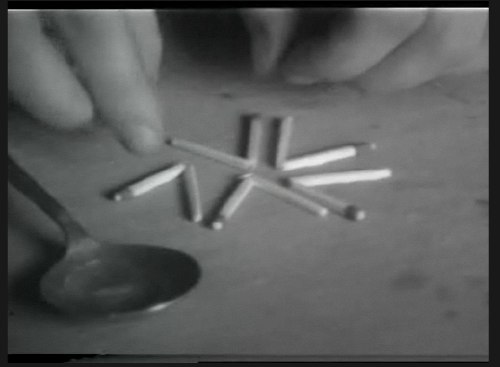William Wegman
Wegman uses the area framed by the camera as his performance space, employing a single, fixed camera to record the scenes as he and Man Ray, his Weimaraner, act them out. It has been suggested that Wegman's performances with Man Ray are uncanny invocations of broadcast television's manipulations of its viewers. Man Ray and his companion are collectively mesmerized by a tennis ball. The misrepresentations and lewd stroking of Man Ray as Wegman delivers a used car salesman's monologue apes television's crass marketing. Man Ray's pursuit of a dog biscuit inside a glass bottle creates the type of narrative suspense that draws us into the action on the screen.
"In a way, [Man Ray is] like an object. You can look at him and say, how am I going to use you, whereas you can't with a person...You can manipulate him so that he doesn't feel manipulated, so that he feels he's doing something he's supposed to do or having fun, one of the two."
—William Wegman (Bear, 1973)
These tapes are a selection from the hours of short performances Wegman recorded in his studio from 1970-1978. Selected Works includes Two Dogs And Ball (silent), Used Car Salesman, Dog Biscuit In Glass Jar
Marina Abramovic: Art Must be Beautiful 1975-76
View a more complete version of this video, and other videos by Abramovic
http://www.ubu.com/film/abramovic_four.html
Interviews with the artist, and current work (2010) from her retrospective, can be seen on the MOMA website:
http://moma.org/interactives/exhibitions/2010/marinaabramovic/
Terry Fox: The Children's Tapes (1974)

Children's Tapes is a classic early video work, a seminal investigation that translates the aesthetics of minimalism, performance, perception and real time into the vernacular of the everyday. With ingenuity and wit, Fox constructs phenomenological dramas from the science of the quotidian. Suspense and surprise suffuse a series of anecdotal episodes that demonstrate basic physical phenomena. Fox builds dramatic tension and mystery with an extreme economy of means, focusing a stationary black-and-white camera on ordinary household objects. With the camera close to his still-life subjects, Fox constructs a series of elementary experiments that illustrate fundamental principles of physical science: A piece of fruit is placed under a tin lid held up by a single match, as an unsuspecting fly approaches the bait; a spoon, balanced on a fork, holds a piece of ice until the melting water topples it; a candle in a pan of water is extinguished when a pot is placed over it. The intimate scale, magnified view, and suspenseful unfolding of minute events in real time all serve to intensify the viewers' perceptions and expectations in these engaging mini-narratives.
Sadie Benning

Sadie Benning is a lesbian videomaker who began making videos when she was 15 years old, using a Fisher Price Pixelvision toy camera. Benning's early works were made in the privacy of her childhood bedroom, using scrawled and handwritten text from diary entries to record thoughts and images that reveal the longings and complexities of a developing identity. Evoking in turn playful seduction and painful honesty, Benning's floating, close-up camera functions as a witness to her intimate revelations, and as an accomplice in defining her evocative experimental form. Her work emerges from a place half-innocent and half-adult—with all the honesty, humor, and desperation of a personality just coming into self-awareness, trapped and uneasy. Her more recent work moves beyond the Pixelvision camera and into animation and film.
Sadie Benning is a 2005 Guggenheim Fellow.
